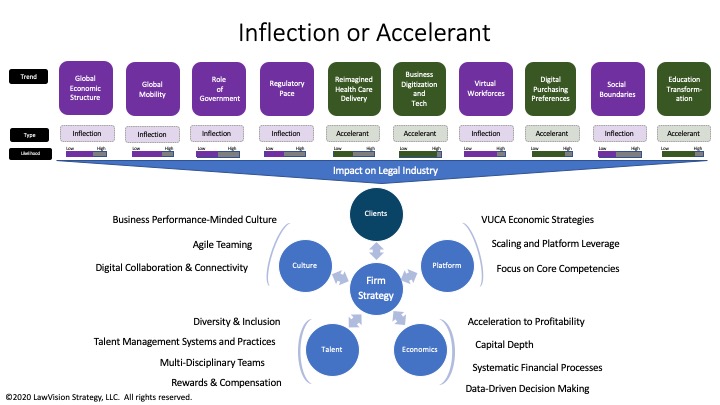By Joe Altonji, Mike Short, Mark Medice and Yvonne Nath
In our COVID-19 Recovery Playbook, we provided our thinking for firm leadership on how to manage through the current crisis. In this four-part continuation of that work, we examine where and how the industry may be shaped by the current health crisis facing the world. In Part 1, we present some thoughts on the types of trends and changes that the crisis has the potential to create in society, and by extension, the legal profession. In Part 2, we look at how client demands might change in light of this pandemic. In Part 3, we look at how these trends might affect the commercial law firm platform. Finally, in Part 4 we discuss how any firm might better prepare itself to weather future “Black Swan” events while coming out the back end in a healthier and better economic position.
As we finally get our arms around the challenges of basic functionality and assuring financial viability through these unprecedented times, it is never too early to begin to think about the long term impact the COVID-19 pandemic might have on the legal profession and industry. Will we somehow fast forward to a “brave new world” (aka “new normal”) radically different than the good old days of February? Or will we somehow get past this and go back to business as usual, albeit with some improved skills around working from home, technology, etc.? Or something in between? Has the COVID-19 pandemic generated a real break point – or inflection point – for the industry, or is it merely a potent accelerant of a number of underlying trends that have been percolating for some time?

How this question ultimately gets answered will depend more than anything else on how the COVID-19 pandemic ultimately changes our social, political, cultural and economic foundations in society as a whole, and to a lesser degree on a country-by-country basis. The short-term changes are obvious to all, and mostly bad, but you can also find many “silver linings” as you see this crisis bringing out the best in most people, and families finding new ways to connect. The longer-term changes are harder to predict with certainty, but some (widely differentiated) potentially permanent inflection points may be possible to see, all of which might affect the legal industry. By way of example, we present our short-list of key societal changes based on what we know today:
- Global Economic Structure – A fundamental rethinking of global economic relationships, especially for the US and Europe, with a shift in thinking away from “cheapest source” alternatives to supply chain security and national self-protection. Should this occur, it will prompt reciprocal rethinking by Asian nations, particularly China, about their economic relationships with the West.
- Global Mobility – Increased attention to rules and regulations around global and international travel, immigration and border control. On a cultural level, at least for the US, we would anticipate at least a medium-term shift away from discretionary and vacation travel internationally, in favor of staying at home.
- Role of Government – Changing expectations for the role of government, and the relationships between state, local and federal entities. Changing priorities for government expenditures and demands on available resources are likely.
- Regulatory Pace – Rethinking of the role and nature of government regulation focused on streamlining approvals and ability to deliver results. While most evident in medical and pharma development, this could be extended to various other areas of government regulation and commercial approval processes.
- Reimagined Health Care Delivery – Accelerated and hopefully serious discussion around how the health care system needs to be designed to assure the health and welfare of all citizens from a delivery of services perspective across States, with the recognition that this may not be the last pandemic to emerge.
- Business Digitization and Tech – Accelerated use of data (big and otherwise) to manage businesses on all levels and across all aspects of business. Predictive analytics take wide hold. Data going well beyond internal financials used to inform decisions and develop/adjust business strategies.
- Virtual Workforces – Normalization of remote work, which is the most obvious change for the legal profession (and not just legal.) This could have fundamental impacts on commercial real estate (obviously) but also has the potential for significantly impacting state-of-residency decisions for many professionals, cross-organization team building, and a wide variety of other organizational approaches. By extension, it could also have the potential to extend the working careers of many professionals.
- Digital Purchasing Preferences – Acceleration of trends away from the use of physical cash, and an acceleration of purchasing patterns away from brick & mortar stores in favor online services with delivery capabilities. Conversely, the potential for smaller, “personal touch” experiences attracting more adherents for non-basic items.
- Social Boundaries – Rethinking of social boundaries in all public spaces, which could have a permanent impact on airlines (demands for greater seat spacing with resulting higher costs and permanent lower demand), restaurants (significantly reducing capacity for any given restaurant size and increasing cost per diner), movie theaters, cruise lines, sporting events, etc.
- Education Transformation – Reconsideration of how education is delivered on all levels. Now that we are learning to deliver education (at least for most purposes) virtually, the potential opportunity for shifting to on-line (and ultimately much lower cost) education could potentially revolutionize the US, at least, as well as other countries.
We could go on, but the point here is not to predict the future but to show that this Black Swan event has the potential to serve as a societal inflection point, in addition to serving as a trend accelerant. The longer this situation continues, the more likely it becomes that the inflection point becomes durable. To the extent that this occurs, the probability of fundamental change to the legal profession that goes beyond the acceleration of otherwise present trends increases. The business and profession of law, after all, reflect the needs and trends of society as a whole, and will adapt to serve those needs in whatever ways are necessary. The legal profession’s core role is to support and facilitate the activities of society – including commercial activity — while protecting the rights and welfare of its members.
See the top section of following chart for further details on each of the changes listed above. In this graphic, we have captured our current thinking on the “trajectory” of each change (inflection or accelerant) and the likelihood of the change. In the bottom of the chart, we offer a preview of the structure of our thinking for coming installments of this series. These (circles) are the key areas related to any law firm where we believe the potential for new trends will be most evident or old trends accelerated, with each area supported by a few example “impacts” on the legal industry.

Will society be different after COVID-19? Almost assuredly. At the very least, it will take some time before people are willing to “go back to normal”, if they ever do. The concept of a true “handshake deal” may be consigned to nostalgia, only because handshakes will take a while to come back, if they do. (We hope they do!). It is probably too early to say how fundamentally society will change, but we can say with certainty that to the extent that it does, the legal industry will change as well. At the very minimum, this crisis will accelerate changes already underway based on trends already evident. In the extreme, it may usher in new changes, both foreseeable and otherwise, based on fundamental changes to our culture, economy and our governance. In the remaining parts of this series, we will explore the range of potential changes to the industry.
©2020 LawVision Strategy, LLC. All rights reserved.



